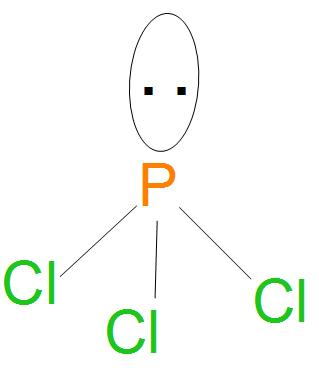Answer
36.9k+ views
Hint: $PC{{l}_{3}}$ is called phosphorus trichloride, which is formed from phosphorus and chlorine. It is actually a very toxic liquid which when reacted with water releases HCl gas. The hybridisation in $PC{{l}_{3}}$is $s{{p}^{3}}$.
Step by step solution:
- Now let’s write the electronic configuration of phosphorus,
The atomic number of phosphorus is 15, so we can write electronic configuration as –
\[1{{s}^{2}}2{{s}^{2}}2{{p}^{6}}3{{s}^{2}}3{{p}^{3}}\]
- Here, if we have to find the hybridisation, then it is equal to the sum of the number of sigma bonds and the number of lone pairs.
- Here, we can see that all bonds are of (P-Cl) type, we can see from the diagram drawn below that there are three P-Cl single bonds present, so the number of sigma bonds will be 3.
- And we can see here that there are 5 electrons present in valence shell that is $3{{s}^{2}}3{{p}^{3}}$, so ; two electrons are not participating in pairing , therefore the number of lone pairs will be equal to 1.
- So, we can say that hybridisation in $PC{{l}_{3}}$is $s{{p}^{3}}$.
- Structure of $PC{{l}_{3}}$ is:

- Hence, from the structure and hybridisation of $PC{{l}_{3}}$ ,we can say that the geometry is pyramidal.
Additional information:
- $PC{{l}_{3}}$ is having a bond angle of approximately .
- $PC{{l}_{3}}$ is found to produce , which are used in many applications, including herbicides, insecticides etc.
- It is also found to be used directly as a reagent in organic synthesis, which is also used to convert many primary as well as secondary alcohols into alkyl chlorides.
Note:
We should not get confused in between $PC{{l}_{3}}$ and $PC{{l}_{5}}$. $PC{{l}_{3}}$ is phosphorus trichloride and is having pyramidal geometry, whereas $PC{{l}_{5}}$ is phosphorus pentachloride that has trigonal bipyramidal geometry.
Step by step solution:
- Now let’s write the electronic configuration of phosphorus,
The atomic number of phosphorus is 15, so we can write electronic configuration as –
\[1{{s}^{2}}2{{s}^{2}}2{{p}^{6}}3{{s}^{2}}3{{p}^{3}}\]
- Here, if we have to find the hybridisation, then it is equal to the sum of the number of sigma bonds and the number of lone pairs.
- Here, we can see that all bonds are of (P-Cl) type, we can see from the diagram drawn below that there are three P-Cl single bonds present, so the number of sigma bonds will be 3.
- And we can see here that there are 5 electrons present in valence shell that is $3{{s}^{2}}3{{p}^{3}}$, so ; two electrons are not participating in pairing , therefore the number of lone pairs will be equal to 1.
- So, we can say that hybridisation in $PC{{l}_{3}}$is $s{{p}^{3}}$.
- Structure of $PC{{l}_{3}}$ is:

- Hence, from the structure and hybridisation of $PC{{l}_{3}}$ ,we can say that the geometry is pyramidal.
Additional information:
- $PC{{l}_{3}}$ is having a bond angle of approximately .
- $PC{{l}_{3}}$ is found to produce , which are used in many applications, including herbicides, insecticides etc.
- It is also found to be used directly as a reagent in organic synthesis, which is also used to convert many primary as well as secondary alcohols into alkyl chlorides.
Note:
We should not get confused in between $PC{{l}_{3}}$ and $PC{{l}_{5}}$. $PC{{l}_{3}}$ is phosphorus trichloride and is having pyramidal geometry, whereas $PC{{l}_{5}}$ is phosphorus pentachloride that has trigonal bipyramidal geometry.
Recently Updated Pages
To get a maximum current in an external resistance class 1 physics JEE_Main

If a wire of resistance R is stretched to double of class 12 physics JEE_Main

Let f be a twice differentiable such that fleft x rightfleft class 11 maths JEE_Main

Find the points of intersection of the tangents at class 11 maths JEE_Main

For the two circles x2+y216 and x2+y22y0 there isare class 11 maths JEE_Main

The path difference between two waves for constructive class 11 physics JEE_MAIN

Other Pages
The escape velocity from the earth is about 11 km second class 11 physics JEE_Main

The nitride ion in lithium nitride is composed of A class 11 chemistry JEE_Main

The ratio of speed of sound in Hydrogen to that in class 11 physics JEE_MAIN

Lowering in vapour pressure is highest for A 02 m urea class 11 chemistry JEE_Main

If a wire of resistance R is stretched to double of class 12 physics JEE_Main

Which of the following is a nonreducing sugar A Glucose class 12 chemistry JEE_Main



